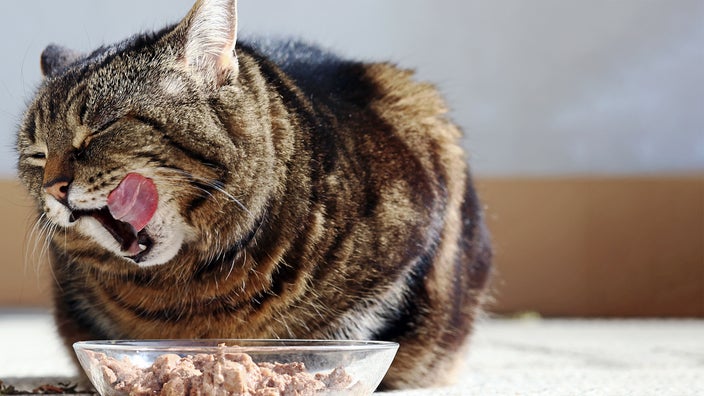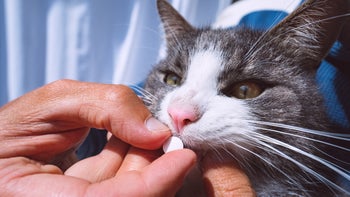
Cat Obesity: Health Risks, Diet, and Prevention
Key takeaways:
Obesity can increase your cat’s risk of serious health issues, including heart disease, arthritis, and high blood pressure.
There are visual signs you can look for to tell if your cat is obese, such as not being able to see their ribs.
It can be tricky to help your cat lose weight, but you can accomplish it through carefully monitored diet and exercise.
Table of contents

To keep your cat healthy, you probably worry about things such as vaccinations, flea control, and quality food. But you could be overlooking one of the greatest dangers to your cat’s health: being overweight.
About 60% of cats in the U.S. were overweight or obese in 2022. This extra weight can have serious implications for your cat’s health. Fortunately, there are many ways to help your cat shed some pounds and stay at an optimum body weight.
What are the health risks with cat obesity?
Obesity poses several major risks to your cat’s health. It can increase your cat’s chances of developing several serious medical conditions, including:
Lameness
Skin conditions
Heart disease
High blood pressure
Shorter lifespan
Search and compare options
If your cat ever needs surgery, being overweight can also increase the chance of anesthesia-related complications.
What causes obesity in cats?
There are also several risk factors that contribute to the chances of your cat becoming overweight.
Age
As cats age and reach senior status, they become less likely to be overweight. Your cat is most likely to be obese between ages 5 and 11.
Breed
Mixed-breed cats are more likely to be obese than purebred cats, such as naturally slimmer breeds including Siamese and Abyssinian.
Neutering
Neutering your cat often reduces their roaming behavior, which may cause male cats to gain weight after surgery.
Medication side effects
Some medications can contribute to weight gain. For example, the steroid prednisolone can lead cats to gain weight.
Read more like this
Explore these related articles, suggested for readers like you.
Health conditions
Some health conditions can contribute to cats gaining weight. In some cases, the health condition might not be the direct cause of weight gain. But pain-related conditions such as arthritis will slow down your cat’s activity, which can lead to weight gain.
Diet
Diet and overfeeding can lead to weight gain in cats. Dry foods, in particular, are high in carbohydrates and calories. “Diets that are high in carbohydrates lead to obesity,” said Jamie Whittenburg, DVM, chief of staff of Kingsgate Animal Hospital in Lubbock, Texas.
Not enough activity
Whittenburg said that while cats in the wild expend lots of energy hunting, modern cats are much less active. Less activity, combined with too much access to food, can lead to weight issues.
How do you tell if your cat is overweight?
You can look at your cat from the top and side to tell if they are overweight. If they are at an appropriate weight, they will look balanced in proportion and not show much fat in their belly region.
“[Looking from above,] cats should have a tuck to their silhouette just in front of their hips,” Whittenburg said. “The ribs and spine should be easily [felt]. If they are not easily felt and the cat does not have a tuck, then your cat is too heavy.”
If your cat is too heavy, you may have trouble feeling their ribs. Looking down at your cat, you might notice only a slight waist or find that your cat’s waist has disappeared. If you can feel heavy fat over your cat’s face and legs, then your cat is at the upper end of the obesity scale.
You may notice that your cat becomes less energetic and playful as they gain weight, too.
How do you help your cat lose weight?
.To help your cat lose weight, Whittenburg recommends making an appointment for a general health check with their veterinarian. They will be able to rule out potential conditions contributing to your cat’s weight.
From there, your vet can create a plan to help your cat safely lose weight. “That plan should include both restricted calories as well as increased activity,” Whittenburg said.
It’s important to understand that, just like in humans, healthy weight loss in cats is a gradual process. Trying to get your cat to lose too much weight too quickly can result in serious conditions such as liver failure.
Instead, stick to your vet’s recommended weight-loss plan. It’s usually safe for cats to lose between 0.5% and 2% of their body weight per month. This typically equates to about 0.25 to 0.5 pounds per month.
What is a recommended diet for overweight cats?
A diet for weight loss will likely be different than just feeding less of your cat’s normal food. Your veterinarian can recommend the appropriate food. Otherwise, your cat may not get all the protein, vitamins, and nutrients they need to stay healthy. Your cat’s normal diet may also be too high in fat.
“Cats are obligate carnivores and do better on diets that contain a high level of moisture and low carbohydrates,” Whittenburg said. “This may be in the form of wet food or a specially formulated home-cooked diet. If the cat has medical issues, there may be a prescription diet that is required.”
Your vet can calculate how many calories your cat should eat each day to effectively lose weight. Then, you can determine how many cups of food is equal to that total calorie count. Don’t forget that treats will add calories to your cat’s daily intake, so it’s best to restrict or eliminate treats to keep your cat at the target calorie count.
You can also consider feeding your cat using food puzzles or automated feeders. These tools can help slow your cat’s eating and prevent them from eating too much too quickly. Puzzle feeders have the added benefit of giving your cat a little bit of extra activity as they hunt for their food.
How much exercise should your cat get?
A general rule of thumb is to try for 15-20 minutes of play per day. You can break these up into 5- to 10-minute sessions.
But the duration of the exercise session will also depend on your cat’s age, weight, and the amount of exercise they previously received. Your veterinarian can provide you with more advice based on your cat’s situation and health.
How to get your cat to exercise
Finding a toy or enrichment activity that your cat truly enjoys can help keep them interested and engaged during exercise time. You may need to focus on interactive play. Here are some potential options:
Wand toys that fly through the air
Wand toys that drag along the ground
Balls or toy mice that cats chase when thrown
Crinkle tubes
Cat trees for climbing
Leash training for safe outdoor exploration
It’s important to tailor an exercise plan to your cat’s health. “For example, playing with toys that cause the cat to jump or start and stop quickly [is] hard on the joints,” Whittenburg said. “[This isn’t] recommended for heavily overweight cats or cats with arthritis.”
You may have to experiment with different toys and exercises until you find something that appeals to your cat. Your goal is to get your cat pouncing, leaping, and being active during these playtime sessions.
What can you do to prevent cat obesity?
One of the best ways to prevent feline obesity is to avoid free-feeding your cat. Rather than leaving a bowl of dry food out all day long, use canned food. Canned food often has a higher protein content than dry food — and it contains fewer carbs, too.
When you feed canned food, you’re more likely to feed structured meals that your cat eats in a single sitting. By feeding your cat at set meal times, you can better control how much your cat consumes, helping to regulate their weight.
If you have multiple cats in your home, feed them separately, so you can regulate how much food each cat eats. Remove any remaining food after 15 or 30 minutes to prevent your cat from coming back for snacks all day long.
Frequently asked questions
It’s hard to know how long an overweight cat will live compared to a normal-weight cat. But a cat’s life expectancy is likely to decrease if they are obese. Obesity can cause health problems that can lead to an earlier death.
Try feeding your cat canned food to lose weight. Canned cat food has less calories and is higher in protein than dry food. Or, talk to your veterinarian about a therapeutic weight-loss diet.
Yes, wet food can help a cat lose weight. Wet canned cat food has less calories than dry.
The bottom line
Obesity in cats has serious health implications, and it can reduce the quality of your cat’s life. You can tell if your cat is overweight by looking at them from above and seeing if they have a noticeable waist or have excess fat around their belly.
If your cat is overweight, be sure to consult with your veterinarian to develop a personalized weight-loss plan. Your cat’s plan will likely include both diet and exercise changes. Some things that might help include switching to canned food and feeding at scheduled meal times. Playing with your cat for 15 to 20 minutes a day is also recommended. Helping your cat lose weight will take some effort, but it will result in a healthier, happier cat.
Why trust our experts?



References
Association for Pet Obesity Prevention. (n.d.). Cat weight-loss.
Association for Pet Obesity Prevention. (2019). 2018 surveys & data.
Cline, M. G., et al. (2021). 2021 AAHA nutrition and weight management guidelines for dogs and cats. Journal of the American Animal Hospital Association.
Cornell University College of Veterinary Medicine. (2024). How often should you feed your cat?
Cornell Feline Health Center. (n.d.). Obesity.
McWreath, A., et al. (2024). Weight loss for obese cats. Veterinary Partner.
Montoya, M., et al. (2023). Life expectancy tables for dogs and cats derived from clinical data. Frontiers in Veterinary Science.
Rand, J. S., et al. (2004). Feline obesity: Causes, consequences and management. World Small Animal Veterinary Association World Congress Proceedings, 2004.
Scherk, M. (2008). Obesity: A complete programme to help cat clients. World Small Animal Veterinary Association World Congress Proceedings, 2008.
Shmalberg, J. (2013). Treatment of obesity in cats and dogs. Today’s Veterinary Practice.
Ward, E. (n.d.). 2023 pet obesity and nutrition survey. Association for Pet Obesity Prevention.



























